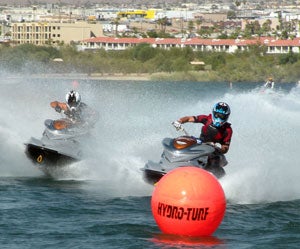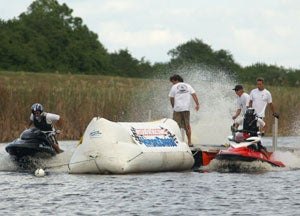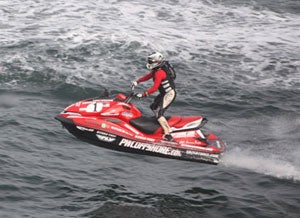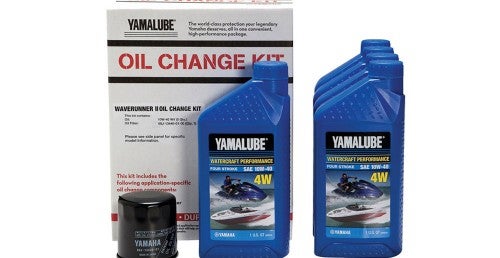How To Become A PWC Racer
Three easy steps to help you get started
The urge to beat your riding buddy across the bay may just be all part of the fun of owning a PWC. But while many PWC enthusiasts will go no further than those local grudge matches, others will find they develop a desire to take things to another level, to compete in an actual organized race.
It’s easier than it looks. Races exist in all forms, and for riders of all skill levels, making the transition far from the daunting task it may seem. Ready to squeeze that throttle? Here’s how to get started.
Choose Your Style
One of your first major considerations should be just what type of racing you want to get into. Closed course is the format many people think of when they picture a PWC race. It typically features a designated “track” of straightaways, left and right turns, and sweeping corners, all marked by colored buoys. It’s exciting head-to-head competition with as many as 12-16 riders, and there are categories for everyone from beginner to pro, with stock machines or highly modified.
 Closed course racing is exciting, but be prepared to deal with hull damage from time to time.
Closed course racing is exciting, but be prepared to deal with hull damage from time to time.Closed course, however, comes with a catch. You better be willing to have your pride-and-joy PWC smacked into. Collisions, fiberglass damage, even injury are all real possibilities in a closed course race. If that sounds like all part of the fun, closed course is for you. If you’re not too thrilled with the idea of doing fiberglass repair, or the potential of contact with another rider, it’s probably an experience you’d rather avoid.
Alternatives? Endurance and offshore racing is becoming increasingly popular. Typically a long-distance competition on rivers, large lakes, or the open ocean, the primary objective is to go the distance. Yes, there’s still the potential for damage or injury, just like any other race, but the likelihood of that happening is far less. Instead, endurance racing is often far more of a test of your ability to go long distance without tiring, battle the elements, even navigate offshore.
And then there’s drag racing. Like you’ve probably done many times before, drag racing just requires you line up alongside another competitor, punch the throttle, and then drive a straight line to the finish, with the fastest being obvious. Organized drag racing, naturally, is a little cooler than just a local grudge match at the lake. Unique starting docks position each rider side-by-side on matching courses and ensure no one gets an advantage at the start. Courses are arrow-straight and well marked. And no, you don’t have to be a performance junkie to participate. While there are classes for highly modified PWC that surpass the 100 mph mark, there are typically also plenty of stock divisions for people with everyday boats.
Who Ya Gonna Call?
 Drag races are fun and generally easy on your equipment.
Drag races are fun and generally easy on your equipment.Ready to squeeze that throttle, but don’t know who to call? Start by checking out the events in your area, and finding out who the sanctioning body is – that will determine just what you need to do next.
To find those races, try Google. It’s an obvious quick search. Or, visit the website of the International Jet Sports Boating Association. This is the primary sanctioning body behind personal watercraft racing. Sign up, pay your membership fee, and you’ll be supplied with a race number, rule book, membership card, and a host of other benefits.
From there, follow the link to find the race promoters in your local area, check out their schedules, and pick a race that looks like it will be fun and tailored to your interests.
And then…
 Offshore racing on a personal watercraft will test your will and endurance.
Offshore racing on a personal watercraft will test your will and endurance.What else? Practice, practice, practice. If you’re preparing for closed course, pick up some buoys, or just a collection of milk or orange juice jugs, connect them to some bricks, anchors, or blocks, and lay out a practice course. Buoys will help you quickly realize that, while you think you know how to turn, you probably really don’t know how to turn. The key? Anticipate the corner. Don’t turn at the buoy, but instead before it. That way your turn will actually take place at the buoy and you’ll continue on course, rather than drift wide and lose valuable time and position.
When you’re confidence has increased, add a friend, or visit a local spot where other riders hang out. Just remember to wear a helmet.
When you’re ready and actually signed up for a race, plan ahead. Don’t wait till the night before the race to gather everything together. Instead, start assembling everything you’ll need – helmet, PFD, gloves, shoes, goggles, gas, tools, etc, etc, etc – in the week leading up to the event. On race morning, get to the event early, unload your craft, and attend the mandatory rider’s meeting. There you’ll find out more details (including the layout of the course), hear the practice schedule, and have the opportunity to ask any questions you may have. Don’t be timid. If you have questions or concerns, speak up. Promoters, and many of your fellow racers, are more than encouraging to newcomers and will help get you settled.
Final suggestion? Whether it’s a closed course, endurance, or drag race, pay attention during practice. This is not the time to show off your skills, but instead make certain you know the course and starting procedure. After all, it’s no use being fast or knowing how to carve that perfect turn if you’re going the wrong direction!
Related Reading
Bushell Leads Sea-Doo Dominance at IJSBA World Finals
BRP Unveils 2013 Sea-Doo X-Team Big Bucks Bounty Program
APBA Offshore National Championship Report
The ABCs of Personal Watercraft Hulls
Understanding a PWC’s Features and How They Benefit You
Five Steps to Finding the Perfect PWC
Get PersonalWatercraft.com in your Inbox!
Like PersonalWatercraft.com on Facebook
Comments
Most Popular

2025 Yamaha JetBlaster PRO 2-Up Review

2024 Kawasaki Jet Ski STX 160X Review

Remembering the Sea-Doo XP

Whatever Happened to the Wetbike?

2025 Yamaha JetBlaster Review













 Your Privacy Choices
Your Privacy Choices